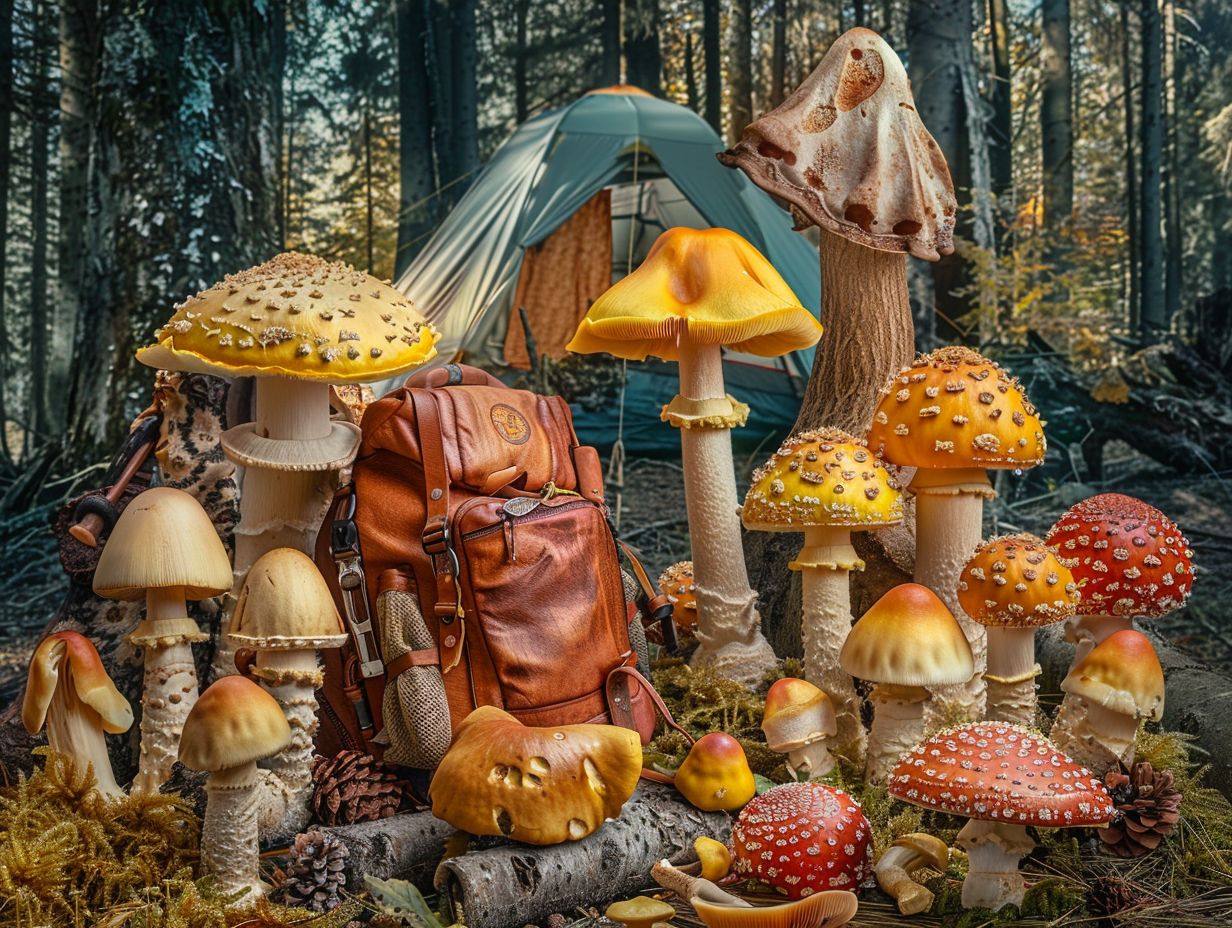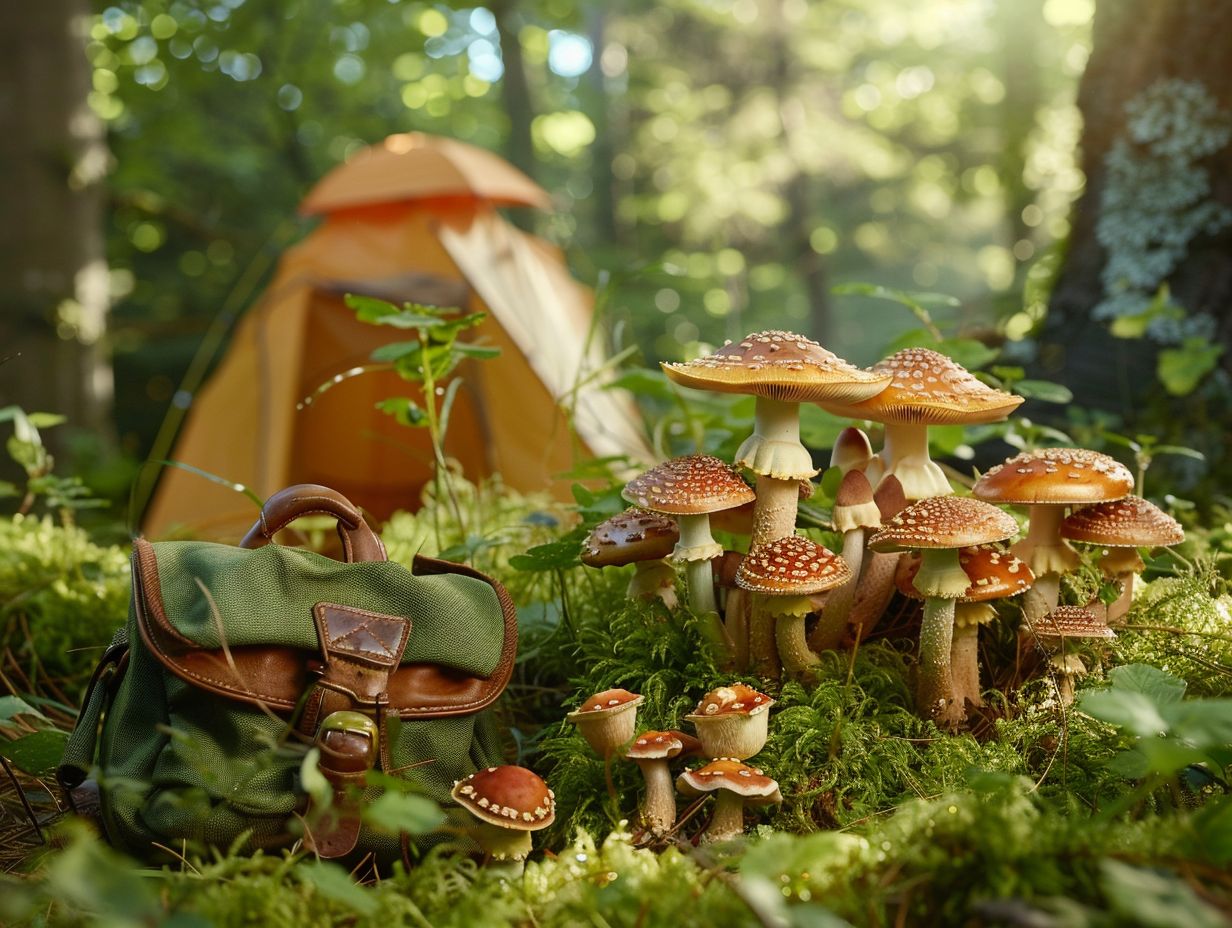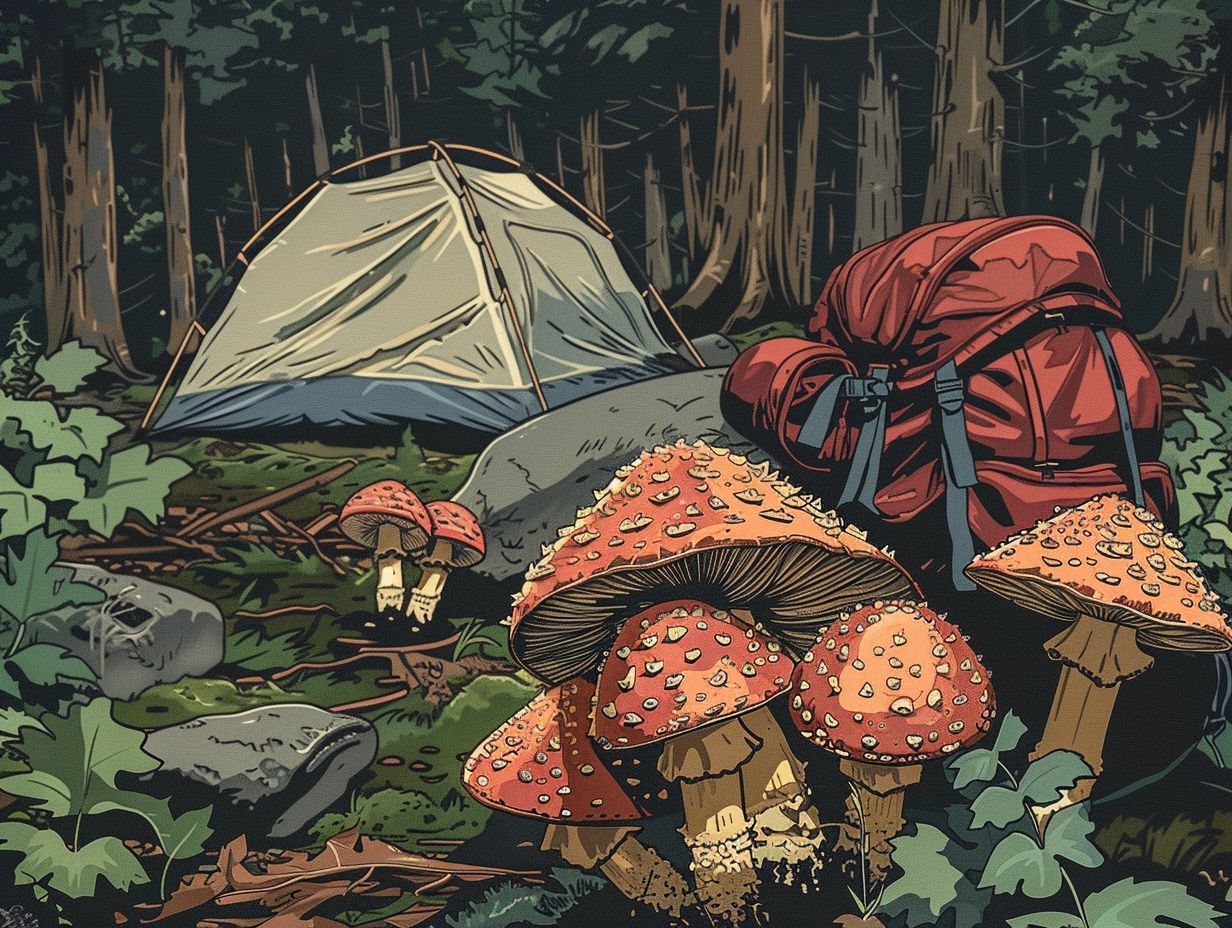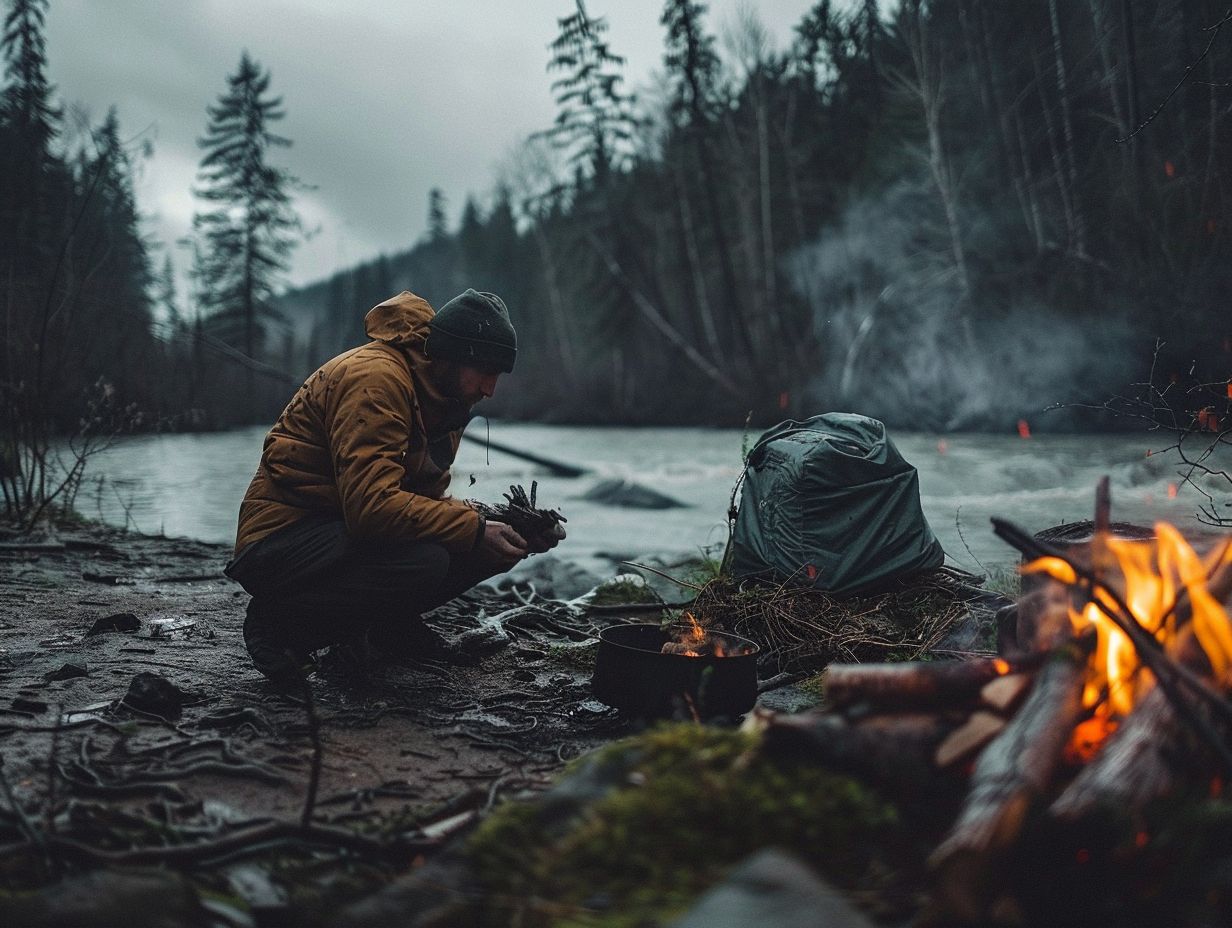If you are an avid camper and nature enthusiast, understanding the types of mushrooms you may encounter in the wild is crucial for your safety and enjoyment.
In this comprehensive guide to mushroom identification, you will explore the common types of mushrooms you may come across, how to distinguish between edible and poisonous varieties, tools and techniques for identification, safety precautions to follow, and tips for successful mushroom hunting.
Stay tuned to learn all you need to know for a successful foraging adventure!
Key Takeaways:

- Knowing how to properly identify mushrooms is crucial for the safety and enjoyment of camping trips.
- Learn to distinguish between edible and poisonous mushrooms by studying their visual and physical characteristics.
- Always take precautions when identifying and handling mushrooms, including using field guides and avoiding common mistakes.
Common Types of Mushrooms in the Wild
Wild mushrooms in North America comprise a wide range of species, covering both edible and poisonous varieties. It is essential for foragers and enthusiasts to have a thorough understanding of the typical mushroom types found in the wild to differentiate between edible delicacies and potentially harmful species.
Identifying Edible vs. Poisonous Mushrooms
Distinguishing between edible and poisonous mushrooms is a critical skill for foragers and mushroom enthusiasts like yourself. Proper identification techniques can prevent potential risks associated with consuming toxic fungi, making it essential for you to learn the key characteristics that differentiate between safe and harmful mushroom species.
One common visual cue used in mushroom identification is the presence of a ring or annulus on the stem, which can indicate a poisonous mushroom. Pay close attention to the colour and texture of the cap and gills, as these features can vary significantly between edible and harmful varieties.
For instance, the fly agaric mushroom, with its iconic red cap speckled with white spots, is easily recognizable as poisonous. In contrast, the chanterelle mushroom’s distinct trumpet-shaped cap and vibrant yellow color are key indicators of its edibility.
Understanding and recognizing these visual cues play a crucial role for you in safely navigating the world of mushroom foraging.
Tools and Techniques for Mushroom Identification
Successful mushroom identification requires using appropriate tools and techniques to accurately differentiate between various species. Field guides and reference materials are vital resources that help mushroom enthusiasts, walkers, and campers identify different mushroom species while participating in outdoor activities.
Field Guides and Other Resources

Using field guides from reputable publishers such as Waterford Press and the National Audubon Society can prove to be invaluable resources for mushroom enthusiasts and foragers in search of accurate information regarding wild mushrooms.
These portable guides offer comprehensive details on mushroom identification, habitats, and characteristics, serving as essential companions for individuals engaging in wilderness exploration activities.
These guides serve a dual purpose, aiding in the identification of both edible and toxic mushrooms while also educating readers on the ecological significance of these fungi within their environments.
By making use of these resources, individuals can expand their knowledge on the various types of mushrooms they may encounter, including their medicinal properties, and how to differentiate between similar species.
The visually appealing illustrations and user-friendly layouts present in field guides contribute to an enhanced learning experience, thereby facilitating the process of mushroom identification, which proves to be accessible and enjoyable for individuals at all levels of expertise, from beginners to experienced foragers.
Visual and Physical Characteristics to Look For
When identifying wild mushrooms, paying attention to visual and physical characteristics is essential in distinguishing between different species. Features such as cap shape, gill structure, stem texture, and spore print colour are crucial indicators that can help you accurately determine the identity of mushrooms.
For example, the cap morphology can vary greatly among mushroom species, ranging from convex to flat or even sunken. Observing the gill arrangement is also vital – noting whether they are attached or free from the stem, and their colour.
Stem features like texture, thickness, and whether it’s solid or hollow provide additional clues. Examining the spore print colour, which can be white, brown, black, or even purple, is a key step in the identification process.
Safety Precautions for Mushroom Identification
Ensuring safety during mushroom identification is crucial for avoiding potential risks linked to misidentifying poisonous species. By adhering to essential safety precautions and guidelines, foragers and enthusiasts like yourself can reduce the likelihood of accidentally ingesting toxic mushrooms, thereby improving your overall mushroom foraging experience.
Avoiding Poisonous Mushrooms
Avoiding poisonous mushrooms is a critical aspect of safe mushroom foraging for you, as misidentification can lead to severe health consequences. By familiarising yourself with common toxic species and adhering to safety guidelines, you can minimise the risks associated with accidentally consuming poisonous fungi.
It is essential for you to understand that some poisonous mushrooms closely resemble edible ones, making it crucial for you to be careful while foraging. Toxic mushrooms like the Death Cap or Destroying Angel have deadly effects if ingested.
When foraging, always use a reliable field guide to differentiate between safe and poisonous mushrooms based on characteristics like colour, shape and scent. Remember, it’s better for you to be cautious and discard a potentially harmful mushroom than risk ingesting an unknown species.
Proper Handling and Preparation
Proper handling and preparation of wild mushrooms are essential steps to ensure a safe and enjoyable culinary experience for you.
From cleaning and cooking techniques to understanding flavour profiles and culinary uses, knowing how to handle and prepare mushrooms correctly can elevate your dining experience as a mushroom enthusiast.
To begin, always start by gently brushing off any visible dirt or debris from the mushrooms instead of soaking them in water, as fungi are porous and can easily become waterlogged. Once cleaned, slicing mushrooms uniformly will ensure even cooking and a consistent texture.
Sautéing mushrooms in butter or olive oil with garlic and herbs can enhance their natural umami flavour. Experimenting with various cooking methods such as roasting, grilling, or pickling can add different dimensions of taste and texture to your dishes, for example, in risottos, soups, stir-fries, and pasta sauces.
Tips for Successful Mushroom Identification

Mastering the successful identification of mushrooms requires you to possess a combination of knowledge, experience, and keen observation skills. By following practical tips and techniques from seasoned foragers and experts in the field, you can enhance your ability to identify a diverse array of wild mushrooms with confidence and accuracy.
Best Times and Places to Find Mushrooms
To maximise your chances of encountering a diverse range of mushroom species, it is crucial to determine the best times and locations for foraging.
Understanding the seasonal availability of mushrooms and the specific habitats where different species thrive can greatly enhance your foraging experience.
In the spring and autumn seasons, numerous mushroom varieties begin to emerge. Spring is particularly ideal for morel mushrooms, while autumn is known for chanterelles. Woodlands, especially oak and beech forests, as well as damp areas and mossy regions, serve as prime habitats for mushroom growth.
It is recommended to explore these environments during humid, warm weather conditions, as mushrooms are more likely to sprout during these times.
When foraging, be observant of the ground cover, as certain species may be hidden under leaves or near tree roots. It is advisable to bring along a guidebook or app to assist in the identification of mushrooms during your foraging expedition.
Common Mistakes to Avoid
Avoiding common mistakes in mushroom foraging and identification can help you reduce risks and inaccuracies in recognizing different species.
By familiarizing yourself with prevalent errors and misconceptions, you can refine your skills and enhance your ability to differentiate between edible and poisonous mushrooms effectively.
One common mistake you should be wary of is relying only on visual cues for identification. While visual characteristics are important, you should also consider other factors such as spore color, habitat, and the presence of any distinctive features.
Misunderstandings about the consistency of mushroom traits can result in misidentifications. It’s important to understand that certain characteristics can vary significantly even within the same species.
Continual learning and exposure to a variety of mushroom species are essential for improving your identification skills and avoiding potentially dangerous misjudgments.
Frequently Asked Questions
What is the purpose of a guide to mushroom identification for campers?
A guide to mushroom identification for campers is designed to help campers identify different types of mushrooms found in the wilderness. It can also provide important information on which mushrooms are safe to eat and which should be avoided.
How can a guide to mushroom identification benefit campers?

A guide to mushroom identification can benefit campers by providing them with knowledge and skills to safely identify and forage for mushrooms during their camping trips. This can add a fun and educational aspect to their outdoor experiences.
Is it safe to eat wild mushrooms found while camping?
While some mushrooms found in the wild are edible and delicious, others can be toxic and even deadly. It is important to be cautious and use a reliable guide to mushroom identification before consuming any wild mushrooms.
What are some common features to look for when identifying mushrooms?
When identifying mushrooms, it is important to pay attention to features such as the cap shape and colour, stem characteristics, gill or pore patterns, and overall size and texture. These can help narrow down the type of mushroom and determine if it is safe to consume.
Where can I find a reliable guide to mushroom identification for campers?
You can find a reliable guide to mushroom identification at outdoor stores, bookstores, or online. It is important to choose a guide written by an experienced mycologist or mushroom expert.
Are there any precautions I should take when using a guide to mushroom identification?
Yes, it is important to remember that a guide to mushroom identification should be used as a reference and not as the sole source of information. It is always best to consult with a professional or experienced forager before consuming any wild mushrooms.



